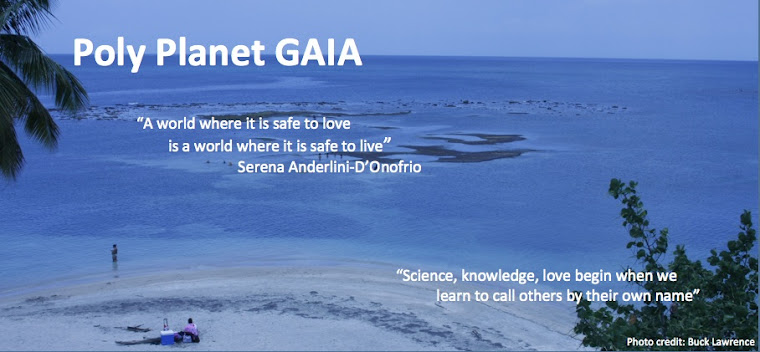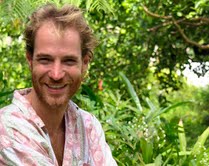"Bisexuality, Gaia, Eros: Portals to the Arts of Loving"
BiReCon: Selected Proceedings from the 2010 Int'l Bisexual Research Conference
Serena Anderlini-D'Onofrio, PhD, Keynote Speaker
Part 1 - Preamble: Manifesting Bisexuality, Cont'd
Back in the 1980s, for bi activists based in the US, part of the vision for bisexuality was the joy of being “out” as people who were “gay” too. The idea was that we too had an affinity for the gay planet, and that as “gays,” united, we would affirm that love is the cure--not the diseas--for our species and the web of life that sustains it. Getting the B in LGBT was an intermediate goal in that long-range vision. However, when that goal was reached, it seems that something happened to the vision. BiReCon was a perfect context to reflect on this. I started pondering questions like, “was there a mixed blessing in the inclusive acronym?” “Did the overall strategy get hijacked for some reason?” The question of marriage equality is often seen as cause for some of the hijacking in both poly and bi circles. However, this is unconfirmed by the latest jurisprudence based on the US Constitution. According to the Finding of Facts and Conclusions of Law in the case that is likely to repeal Proposition 8 (and hopefully deter any such future initiatives), marriage equality is based on gender equality and one’s right to marry those who inspire one with “tender feelings” (Perry vs. Schwarzenegger 2010: 13, 43). It looks like marriage equality is poised to become a 14th Amendment issue. Experts describe sexual orientation as a “relational construct” and speak of three groups for whom equal protection can be invoked, at least as a possibility: “heterosexual, homosexuals, and bisexuals” (71). “Regulating filiation” is only a secondary purpose of marriage, since older and infertile people are allowed to marry too (13, 41). In the long range, marriage equality for all “gay” people is likely to transform the institution of marriage in directions that may be very widely inclusive of erotic and amorous diversity. Yet perhaps there are reasons why this victory seems Pyrrhic. In the short range, the high priority given to this issue does have an effect on bisexual people. Posturing for marriage eligibility involves a certain repudiation of non-monogamy, a certain acceptance of normativity. This posturing has happened while the question of pleasure, and the erotic practices that accrue it in relation to a sense of holistic health and well-being, is still in limbo. While female bisexuality can easily pass for a harmless divertissement, or, to extend the culinary metaphor, a hors d’oeuvre to whet the palate before the real meal, it seems as if bisexual men, equipped with the “weapon” most often considered vehicle of infection, have been saddled with the stigma of aberrant and predatory behavior.
Here are some examples from current social media. Dan Savage is a major LGBT columnist based in the US who to his credit believes that non-monogamy can be practiced responsibly.[1] However, when it comes to bisexuality he conspicuously posts derogatory videos on YouTube, as in “The Bizarre World of the Bisexual,” by one “Mister Sharp.”[2] Why does Savage get mileage with his followers from doing this? What’s the point of reiterating the litany that bisexual people don’t make “good relationship material”? Bisexuals, dear Dan, make excellent relationship material depending on the kinds of relationship systems one wants. Ask me! I only date men who are bisexual because as an artist of love I appreciate their enhanced capability to know those who are like them and love them intimately. What could make better “relationship material” than people with a special, inclusive talent for the art of love? Cultivating those talents is all one has to do![3] The reason why relationships come apart more often than we’d like sometimes is that we all live in a regime of serial monogamy. If amorous inclusiveness was more accepted, those with the capability to expand their love would simply add one member to the family.
One way to assess webs and flows in socially transformative movements is to look at parallels between movements with affinities for one another. In the early 1990s, at least in the US, the B in LGBT was a catalyst issue. Female leadership in the bi movement was undisputed. The issue of inclusion can be compared to the issue of the vote in the women’s equality movement in the early 20th century. The vote marked a significant turning point in the countries where suffrage was won around World War I. And yet, for women in those countries, the vote had the side effect of hijacking other important issues, like equal pay for equal work or equality in the home and bedroom. For women in other countries, the effects were often even worse. So for the bisexual movement, the B in the LGBT acronym repositioned bisexuals as part of those capable of envisioning a “gay” future for Gaia. But it also had the double negative effect of temporarily de-energizing the movement based on the perception that a major advantage had been won, and of positioning bisexuality within a cultural location that was not prepared to honor its complexity or understand it for what it was.
Before the conference, I thought about the biphobia that’s part of my personal experience as a result of my relatively tucked away location in non-metropolitan Western Puerto Rico. One small example will suffice. In this region, I was one of the main energizers of the only secular LGBT community discussion group to have prospered in the past 15 years, West PR Friends. I educated participants about bisexuality and polyamory profusely. At the end of two years, only 10 percent of members claimed they’d form a relationship with a bisexual person! That’s how prejudiced the LGBT world still is. Fortunately, one such person is all I needed. And I found her! But for a long time I believed I should have been in London, Paris, New York, or San Francisco. Part of my involvement with polyamorous communities is a result of them being hospitable havens for bisexuals, and organized as networks that spread their wings over entire regions rather than being based in a specific city. The experience of BiReCon and BiCon helped me realize my situation is more typical than I thought it would be. It would appear that when considering bisexuality on a global scale, what we bi activists of the late 20th century aspired to was a modest victory whose cost was just as high and in some cases higher than the prize won. As erotophilia expanded in the secular mainstream to include LGBT people, the B did provide some protection for bi people. However, this very same inclusion made bis more vulnerable scapegoats within gay institutions. As a cultural space where love can be practiced regardless of gender, bisexuality ultimately encourages love for the person. It is a piece of the puzzle in the project of affirming the force of love. Today I am even more persuaded that, as a transformative force, bisexuality cannot exist alone. It intersects with other amorous variants and options that open up horizons for expression to those interested in genuine, authentic, imaginative, and respectful ways to practice love.
Read the article as it continues to continues to appear in Poly Planet GAIA. Section will be posted every three or four days. Become a follower of the blog and be notified every time a new posting appears.
Acknowledgment: This piece is pre-published here with permission of Routledge, New York, a division of Taylor and Francis.
BiReCon | 28 BiCon | 10 ICB
BiReCon Proceedings: A forthcoming issue of The Journal of Bisexuality
Bisexuality Research Conference, 28th Bisexuality Conference, 10th International Conference on Bisexuality, London, UK, August 26-30, 2010
BiReCon Proceedings: A forthcoming issue of The Journal of Bisexuality
[1] See interview by Annie Corrigan, http://kinseyconfidential.org/dan-savage-3-non-monogamous/
[3] This idea of cultivating talent in the arts of loving so as to create complex and fulfilling relationship network systems conducive of creative intelligence and even genius was not lost on people raised in such emotionally sustaining circles. A good example is Burgo Partridge, raised in the early 20th century in the Bloomsbury literary experimental community, who grew up to be exceptionally knowledgeable in the arts of loving (Partridge 2002).








